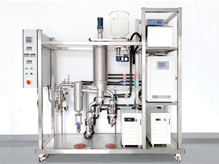Short-range molecular distillation unit workflow
The short-range molecular distillation device is suitable for molecular distillation, heating the feed liquid to partially vaporize it, the volatile component is concentrated in the vapor, and the hard-to-volatile component is also concentrated in the remaining liquid, which is realized to some extent. Separation of the two components. The greater the difference in the volatilization ability of the two components, the greater the degree of enrichment described above. In an industrial rectification plant, a partially vaporized liquid phase is directly contacted with a partially condensed gas phase for vapor-liquid phase mass transfer, and as a result, a partially volatile component in the gas phase is transferred to the liquid phase, and the liquid phase is easy. Part of the volatile component is transferred to the gas phase, that is, partial vaporization of the liquid phase and partial condensation of the vapor phase are simultaneously achieved. The molecules of the liquid tend to overflow from the surface due to molecular motion. This tendency increases as the temperature increases. If the liquid is placed in a closed vacuum system, the liquid molecules continue to overflow and form a vapor on the upper surface of the liquid, and finally the rate at which the molecules escape from the liquid is equal to the rate at which the molecules return from the vapor to the liquid, and the vapor remains constant. pressure.
The distillation process of the short-range molecular distillation unit is as follows:
1. Molecules diffuse from the liquid phase body to the evaporation surface: Generally, the diffusion rate in the liquid phase is the main factor controlling the molecular distillation speed, so the thickness of the liquid layer should be reduced as much as possible and the flow of the liquid layer should be strengthened.
2. Free evaporation of molecules on the surface of the liquid layer: The evaporation rate increases with the increase of temperature, but the separation factor sometimes decreases with the increase of temperature, so it should be based on the thermal stability of the material to be processed. Choose an economically reasonable distillation temperature.
3. Molecules fly from the evaporation surface to the condensation surface: During the process of vapor molecules evaporating from the evaporation surface to the condensation surface, they may collide with each other or may collide with air molecules remaining between the two sides. Since the evaporation molecules are much heavier than the air molecules and mostly have the same direction of motion, their own collisions have little effect on the direction of flight and the rate of evaporation. The residual gas molecules have a chaotic thermal motion between the two sides, so the number of residual gas molecules is the main factor affecting the direction of flight and the evaporation rate.
4. Molecular condensation on the condensation surface: As long as there is sufficient temperature difference between the hot and cold sides (generally 70~100°C), the condensation surface is reasonable and smooth, and the condensation step can be completed in an instant.

- High-tech Zone, Zhengzhou City, Henan Province, China.
- +86 132 9817 7608
- info@rotovap-wellknown.com
- li249869402
Copyright © Zhengzhou Well-known Instrument & Equipment Co.,Ltd. All Rights Reserved Sitemap










